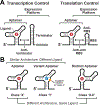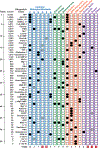The Biochemical Landscape of Riboswitch Ligands
- PMID: 35068140
- PMCID: PMC9971707
- DOI: 10.1021/acs.biochem.1c00765
The Biochemical Landscape of Riboswitch Ligands
Abstract
More than 55 distinct classes of riboswitches that respond to small metabolites or elemental ions have been experimentally validated to date. The ligands sensed by these riboswitches are biased in favor of fundamental compounds or ions that are likely to have been relevant to ancient forms of life, including those that might have populated the "RNA World", which is a proposed biochemical era that predates the evolutionary emergence of DNA and proteins. In the following text, I discuss the various types of ligands sensed by some of the most common riboswitches present in modern bacterial cells and consider implications for ancient biological processes centered on the proven capabilities of these RNA-based sensors. Although most major biochemical aspects of metabolism are represented by known riboswitch classes, there are striking sensory gaps in some key areas. These gaps could reveal weaknesses in the performance capabilities of RNA that might have hampered RNA World evolution, or these could highlight opportunities to discover additional riboswitch classes that sense essential metabolites.
Figures



References
-
- Sherwood AV; Henkin TM Riboswitch-mediated gene regulation: novel RNA architectures dictate gene expression responses. Annu. Rev. Microbiol 2016, 70, 361–374. - PubMed
-
- Bédard AV; Hien EDM; Lafontaine DA Riboswitch regulation mechanisms: RNA, metabolites and regulatory proteins. Biochim Biophys Acta Gene Regul. Mech 2020, 1863, 194501. - PubMed
-
- Husser C; Dentz N; Ryckelynck M Structure-switching RNAs: from gene expression regulation to small molecule detection. Small Structures 2021, 2, 2000109.
Publication types
MeSH terms
Substances
Grants and funding
LinkOut - more resources
Full Text Sources

